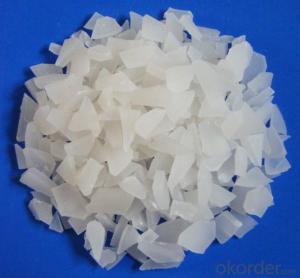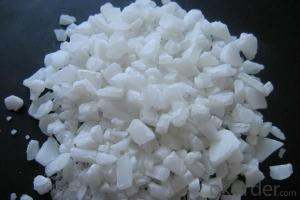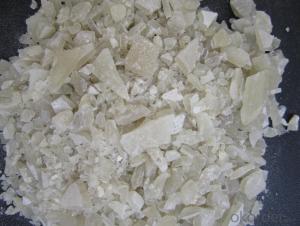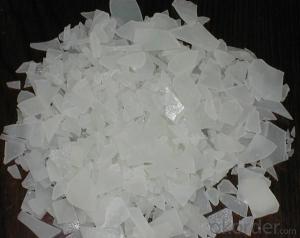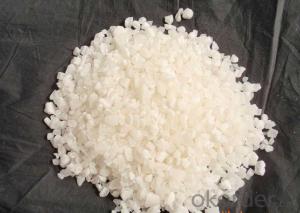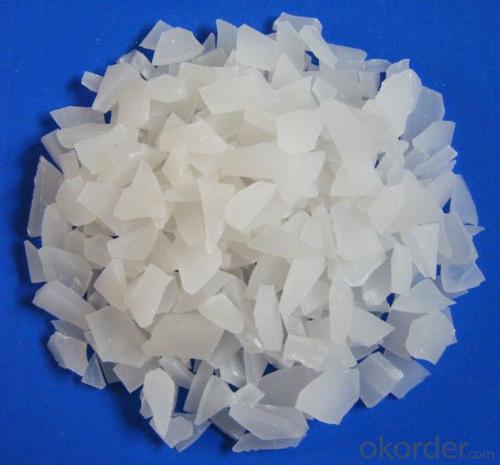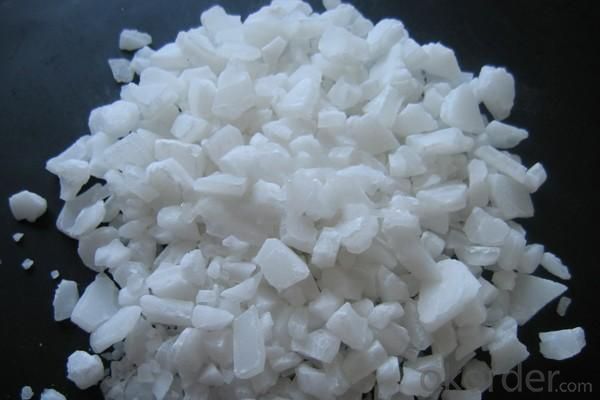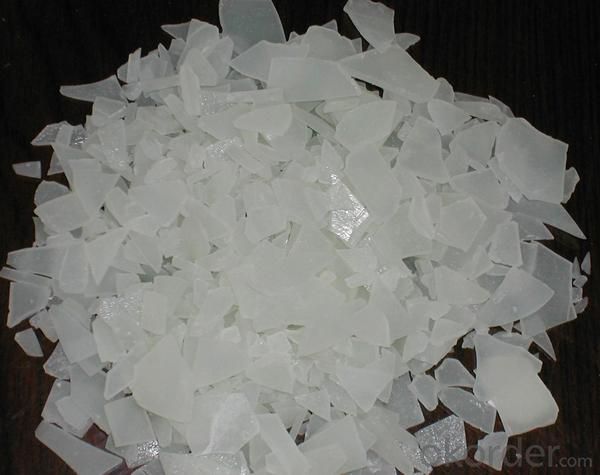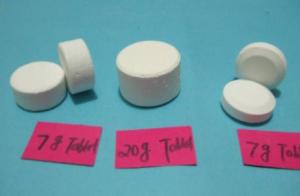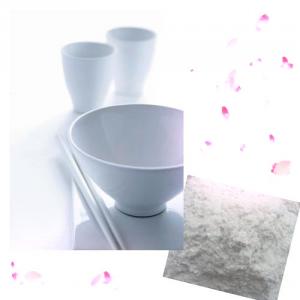Aluminum Sulfate Low Fe Qualifed Grade Manufacturer in China
- Loading Port:
- Qingdao
- Payment Terms:
- TT OR LC
- Min Order Qty:
- 25 m.t.
- Supply Capability:
- 12000 m.t./month
OKorder Service Pledge
OKorder Financial Service
You Might Also Like
1. Chemical and Physical Properties:
Product name: Aluminium Sulphate or Aluminum Sulfate
Shape: Flakes or Granular or Powder.
EINECS NO.:233-135-0
CAS No.: 10043-01-3
HS.Code: 28332200
Molecular Formula: Al2(SO4)3
Appearance:It is white or grey flake,particle or massive crystallization.
Apt to cake after moisture absorption when laid in air for a long time.A little green because of Fe2+ ,yellow when Fe2+ is oxided to Fe3+.Soluble in water easily,and water solution is acid.
2. Specification:
Standard: HG/T 2225-2001 and HG/T 2227-2004
Items | Specifications | |||
I Type:Low Ferrous/Low Iron | II Type:Non-Ferrous/Iron-free | |||
First Class | Qualified | First Class | Qualified | |
Al2O3 % ≥ | 15.8 | 15.6 | 17 | 16 |
Ferrous(Fe )% ≤ | 0.5 | 0.7 | 0.005 | 0.01 |
Water Insolube % ≤ | 0.1 | 0.15 | 0.1 | 0.15 |
PH (1% aqueous solution) ≥ | 3.0 | 3.0 | 3.0 | 3.0 |
Arsenic(As) %≤ | 0.0005 | 0.0005 | ||
Heavy metal (Pb) %≤ | 0.002 | 0.002 | ||
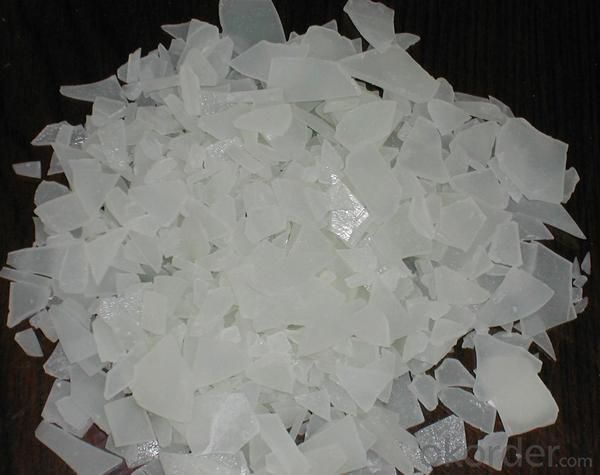
3.Applications:
Water effluent treatment system
It's used for purification of drinking water and wastewater treatment by settling of impurities by
means of precipitation and flocculation.
Paper Industry
It helps in sizing of paper at neutral and alkaline pH, thus improving paper quality (reducing spots
and holes and improving sheet formation and strength) and sizing efficiency.
Textile Industry
It is used for color fixing in Naphthol based dyes for cotton fabric.
Other Uses
Leather tanning, lubricating compositions, fire retardants; decolorizing agent in petroleum, deodorizer; food additive; firming agent; dyeing mordant; foaming agent in firefighting foams; fireproofing cloth; catalyst; pH control; waterproofing concrete; aluminum compounds, zeolites etc.
4. Package:
Packaging Detail: PP/PE 50kg/bag;25kg/bag;Jumbo bag or according to customers' requirements.
20-25MT will be loaded in per 20'FCL container.
5. Attention and Storage:
The product is liable to absorb moisture and clot due to long-term exposure, so shady, cool and ventilated environment is needed.
- Q: Why the catalyst after the chemical reaction of its quality and chemical properties unchanged
- The catalyst does not react directly with the reactants, so its mass remains constant.
- Q: why is palladium/platinum a good catalyst?
- Sparky 22 is wrong. Metals like palladium and platinum and nickel do absorb hydrogen. For example many times when doing a catalytic hydrogenation with Raney-Nickel you do not need to add H2 because enough H2 is already absorbed on the metal.
- Q: What about the chemical reaction of the catalyst if there is no catalyst?
- The catalyst used to heat and hold, the material will not react between.
- Q: A catalyst elevates the rate of a reaction by?
- reducing the energy required for the reactants to reach the transition state.
- Q: explain how a catalyst can affect the rate of reaction but not be in the overall equation.?
- a catalyst is a substance that speeds up the rate of reactions that would already happen (the reactions are spontaneous) but would take a long long time to occur. Every reaction proceeds from a level of high energy to a lower level of energy, but in order to start going downhill you need to get up, in affect getting more energy than the reactants have now. This is because the transition state, or what the reactnat/product is in the middle of the reaction, is less stable and requires more energy than the reactants. Catalysts lower the extra energy needed (called activation energy) to a level that the reactants already have, and the reaction occurs.
- Q: Is palladium predominantly a catalyst in chemistry?
- Palladium in the chemical mainly to do the catalyst; palladium and ruthenium, iridium, silver, gold, copper and other alloy, can improve the palladium resistivity, hardness and strength, used in the manufacture of precision resistors, jewelry and so on.
- Q: It's a GCSE Chemistry questionI just need to know why there are so many
- Many important chemical reactions require inputs of energy to proceed. If a catalyst is present less energy will be required to complete the reaction. Catalysts are substances that are mixed in with materials that are to be reacted, but they themselves do not, in the end, change chemically. They establish a local environment that promotes one or more chemical reactions to take place. A catalyst is important in many industrial processes. Sulfuric acid, which is used to produce batteries, detergents, dyes, explosives, plastics, and many other produces, is commonly produced using a catalyst called vanadium oxide. Ammonia, a primary component of many fertilizers, could not be produced economically without the use of iron oxide which speed up the reaction. The process of catalyst also affects the state of our global environment. Automobiles use catalytic converters to treat exhaust. The metals platinum and palladium facilitate the chemical conversion of noxious gases to more inert forms, greatly decreasing the environmental impact of combustion engines. Probably the most important impact of catalyst is on life itself. All important biochemical reactions are catalyzed by molecules called enzymes. Most enzymes are proteins which catalyze specific reactions within cells. Some examples include polymerases, which synthesize DNS and RNA, peptidases, which digest protein, and ATP synthases, which produce energy for the many different cell activities.
- Q: High school stage which organic chemical reactions do not use catalyst
- Olefins, alkynes, making bromine water, potassium permanganate fade.
- Q: i keep messing up on those 2 simple things haha i would apprecaite some help.
- A catalyst is a substance that affects the rate of a reaction. It may participate, but cannot be consumed in the reaction. For example, KMnO4 catalyzes the breakdown of H2O2 into H2O and O2. In the end, as much KMnO4 exists as did in the beginning. An enzyme is a biochemical reagent that allows an organism to convert a compound into other compounds. This is part of metabolic processes. For example, maltose (a sugar composed of a chain of two glucose molecules) can be broken down into glucose by the maltase enzyme. Unlike a catalyst, enzymes may or may not be consumed/altered in the metabolic processes.
- Q: Why would the Eact decrease if a catalyst is added?
- Catalysts work by providing an (alternative) mechanism involving a different transition state and lower activation energy. The effect of this is that more molecular collisions have the energy needed to reach the transition state. Hence, catalysts can perform reactions that, albeit thermodynamically feasible, would not run without the presence of a catalyst, or perform them much faster, more specific, or at lower temperatures. This can be observed on a Boltzmann distribution and energy profile diagram. This means that catalysts reduce the amount of energy needed to start a chemical reaction.
Send your message to us
Aluminum Sulfate Low Fe Qualifed Grade Manufacturer in China
- Loading Port:
- Qingdao
- Payment Terms:
- TT OR LC
- Min Order Qty:
- 25 m.t.
- Supply Capability:
- 12000 m.t./month
OKorder Service Pledge
OKorder Financial Service
Similar products
Hot products
Hot Searches
